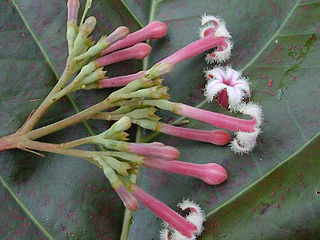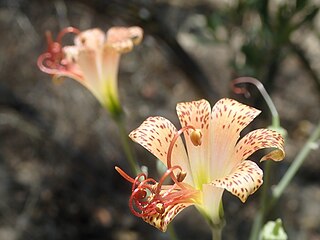
Toxicodendron is a genus of flowering plants in the sumac family, Anacardiaceae. It contains trees, shrubs and woody vines, including poison ivy, poison oak, and the lacquer tree. All members of the genus produce the skin-irritating oil urushiol, which can cause a severe allergic reaction. The generic name is derived from the Greek words τοξικός (toxikos), meaning "poison," and δένδρον (dendron), meaning "tree". The best-known members of the genus in North America are eastern poison ivy (T. radicans) and western poison oak (T. diversilobum), both ubiquitous throughout much of their respective region.

Alzatea verticillata is a small flowering tree, native to the Neotropics. It inhabits moist submontane forests from Costa Rica and Panama in Central America south to Peru and Bolivia in tropical South America. It is the sole species of genus Alzatea and family Alzateaceae.

Nierembergia, common name cupflower, is a genus of plants in the nightshade family. It is named after the Spanish Jesuit and mystic Juan Eusebio Nieremberg (1595-1658).

Iriartea is a genus in the palm family Arecaceae. It is native to Central and South America. The best-known species – and probably the only one – is Iriartea deltoidea, which is found from Nicaragua, south into Bolivia and a great portion of Western Amazonian basin. It is the most common tree in many forests in which it occurs.
Margyricarpus is a genus of flowering plant in the family Rosaceae, native to South America.

Cinchona pubescens, also known as red cinchona and quina or kina, is native to Central and South America. It is known as a medicinal plant for its bark's high quinine content- and has similar uses to C. officinalis in the production of quinine, most famously used for treatment of malaria.
Angylocalyx talbotii is a species of flowering plant in the family Fabaceae. It is found in Cameroon and Nigeria. Its natural habitat is subtropical or tropical moist lowland forests. It is threatened by habitat loss.

Axinaea is a genus of flowering plants in the family Melastomataceae. As of 2012, there are at least 42 species. They are small trees and shrubs. They are native to the Americas; almost all are found in the Andes.
Huertea is a genus of plant in family Tapisciaceae. It is native to central and south America. Species include:

Sessea is a genus of 19 accepted species of shrubs, small trees and climbers belonging to the subfamily Cestroideae of the plant family Solanaceae. The flowers of Sessea are so similar to those of Cestrum that the genera cannot usually be told apart, unless the plants are in fruit. Then their distinguishing characteristics become immediately apparent; plants of the genus Sessea bearing dehiscent capsules dispersing winged seeds, while those belonging to the genus Cestrum bear juicy berries containing prismatic seeds. The flowers of both Sessea and Cestrum have tubular corollas that are long exserted from small calyces.

Heteranthera is a genus of aquatic plants in the water hyacinth family, Pontederiaceae, known generally as mud plantains. Species of this genus are native to tropical and subtropical America and Africa. They live in the water or in wet soils. They produce leaves on long petioles and some are cultivated for their attractive flowers. Leaves are of two types - linear and submerged or orbicular and floating. Some species have cleistogamic flowers.

Solanum lanceolatum, with the common names orangeberry nightshade and lanceleaf nightshade, is a species of nightshade. It is native to regions of South America, including the Cerrado ecoregion of the Tropical and subtropical grasslands, savannas, and shrublands biome, primarily in Brazil.

Bowlesia incana is a species of flowering plant, known by the common name hoary bowlesia, in thefamily Apiaceae. It is native to South America and the southeastern and southwestern United States as far north as Washington. It can also be found in Pakistan and New Zealand as an introduced species. It grows in many types of habitat. This is a small annual herb growing thin, spreading stems less than 60 centimeters long. The leaves are borne on long petioles and have multilobed rounded or kidney-shaped blades less than 3 centimeters wide. The green herbage of the plant is coated in fine white hairs. The inflorescences of yellow-green flowers appear in the leaf axils. The tiny inflated fruit is only 2 millimeters wide.

Porlieria is a genus of flowering plants in the caltrop family, Zygophyllaceae. Species within this genus are shrubs or small trees of dry subtropical regions. The generic name honours Spanish ambassador Don Antonio Porlier de Baxamar.
Tabernaemontana sananho is a tropical tree species in the family Apocynaceae known as lobo sanango. Lobo sanango grows in the Amazon Basin of northern South America.
Escobedia is a genus of flowering plants belonging to the family Orobanchaceae.
Ruizodendron is a monotypic genus of flowering plants belonging to the family Annonaceae. It is part of Malmeoideae subfamily and Malmeeae tribe. The only known species is Ruizodendron ovale.

Alstroemeria versicolor is a species of plant in the family Alstroemeriaceae. It is a perennial herb endemic to Chile, where it is distributed between the Santiago Metropolitan and Araucanía regions.

Alstroemeria revoluta is a species of plant in the family Alstroemeriaceae. It is a perennial herb endemic to Chile, where it is distributed between the Valparaíso and Araucanía regions.














